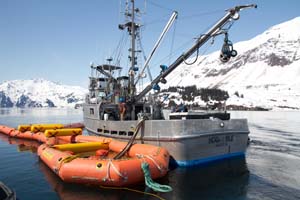
The Fishing Vessel Training program in Prince William Sound is a mechanism that allows immediate response to an oil spill by contracted fishing vessels and experienced crew. Trained, on-call fishing vessels and crew are an important part of oil spill response operations.
The program maintains a database of fishing vessels throughout the region. The core fleet, also called Tier I, located within Prince William Sound, are considered “first responders” to a spill. Other ports outside the Sound are ready to provide hundreds of fishing vessels for response activities. The vessel crews are trained each year and are highly skilled in deploying, operating, and maintaining oil spill equipment. This program is vital to an oil spill response in our region. It is important that the program is maintained and funded by Alyeska’s Ship Escort Response Vessel System (SERVS) and that the program is able to maintain the numbers of vessels mandated by the Tanker Contingency Plan.
The program is revised as new technologies or tactics become available and as a result of lessons learned during drills, exercises, or incidents. Fishing vessel training is generally held in spring and late fall to avoid direct conflict with fishing seasons.
Alyeska’s SERVS oversees the fishing vessel training program with occasional help from other companies.
Fishermen are paid a certain amount per vessel foot to contract as a responder. They are also paid for training. In addition, the core fleet receives money to keep vessels maintained throughout the winter.
Communities within Prince William Sound as well as Kodiak, Seward, Homer, and Kenai participate in the training, which typically consists of three days of instruction including classroom, hands-on experience, and on-water exercises.
Classroom instruction includes orientation, incident command systems, response strategies and tactics, rigging for safety, site characterization, and the use of gas meters to determine air quality (for instance, levels of oxygen, harmful vapors, or explosive atmosphere status). Hands-on training consists of equipment familiarization and operation for booms, skimmers, personal protective equipment, mini barges, field first aid, and other tools and skills. On-water exercises include training with a nearshore response barge and/or landing craft. All fishing vessel training includes interactive communications to gain and use local knowledge and experience. Instructors are SERVS response personnel, TCC subject matter experts (TCC is a SERVS contractor), and Prince William Sound Community College staff.
Obligations of a Contracted Vessel
If a spill occurs, fishing in the immediate region is likely to be shut down temporarily, so vessels and crew that normally would be fishing would be available for spill response. Tier I vessels—the core fleet—are called first, are expected to respond, and would be the first fishing vessels on-scene. Response from all contracted fishing vessels, however, is subject to availability.
Vessel and Crew Capabilities
- Contain spilled oil
- Collect spilled oil
- Plan and identify sensitive habitat
- Maintain and repair equipment
- Clean boats, harbors, and shorelines
- Provide logistics support
- Provide public information
- Assess damage
- Provide floating housing for marine work crews
- Transport food, equipment, and people
- Provide communication equipment and command post space
Tiers of Vessels
There are two types of contracted vessels: pre-incident and post-incident. Pre-incident contracted vessels include Tier I or “core fleet” and Tier II. Post-incident vessels include Tier III vessels.
Tier I and Tier II vessels receive the same type of training. Tier III vessels are “vessels of opportunity,” those that have not participated in training and are not pre-contracted. They may show up just after an oil spill wanting to help in any way possible. They are at that time given training adequate to their assigned job.
- Tier I: pre-contracted, pre-trained, core fleet
- Tier II: pre-contracted, pre-trained
- Tier III: not pre-contracted, trained as needed
Reports and Additional Reading:
| View additional details | Author | Date | Description | View Document |
|---|---|---|---|---|
| Fishing Vessel Training Fact Sheet – Updated September 2014 | PWSRCAC | September 5, 2014 | Overview of APSC/SERVS fishing vessel response program. | |
| 2011 Fishing Vessel Owner Meeting | Jeremy Robida, PWSRCAC | March 7, 2011 | The Council hosted this meeting was to engage with representatives from the fishing vessel (FV) spill response program and dialogue on the overall health and well-being of that program. | |
| APSC SERVS Fishing Vessel Review | Harvey Consulting, Susan Harvey | May 20, 2009 | This 2009 report assessed how ready the fishing vessels on contract to Alyeska Pipeline Service Company’s Ship Escort Response Vessel System are to respond to a major oil spill from … | |
| Fishing Vessel Types Fact Sheet | March 9, 2007 | Three main types of fishing vessels are available for oil spill response through Alyeska’s Ship Escort Response Vessel System (SERVS) fishing vessel training program in Prince William Sound: seiners, stern … | ||
| SERVS’ Fishing Vessel Program Meeting in 2005 | Joe Banta, Linda Swiss, Roy Robertson | December 8, 2005 | On December 8, 2005, the Council hosted a meeting with fishing vessel captains participating in the SERVS’ fishing vessel (F/V) program. | |
| March 2005 SERVS Fishing Vessel Training Program | Roy Robertson | March 28, 2005 | Report by PWSRCAC on spring 2005 fishing vessel training in Kodiak, Homer, Seward, Valdez, Cordova, Chenega, and Whittier from March 28 – May 5, 2005. | |
| Notes from the March 6, 2024 SERVS Contracted Vessel Fleet Representative Meeting | Jeremy Robida, PWSRCAC | This report summarizes discussions during a meeting of representatives from the contracted vessel fleet. Attendees discussed program health and port-specific concerns. |